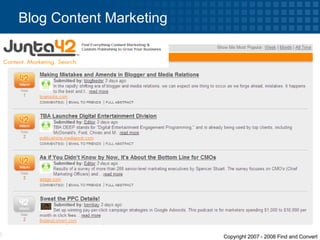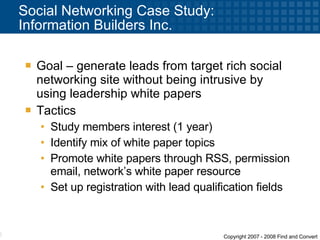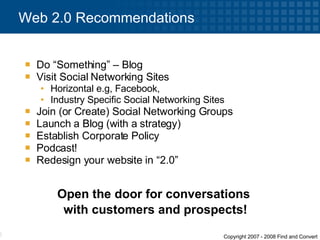Tech Select Web 2 0 Presentation
- 1. Social Media Optimization – What B2B Marketers Need to Know About Web 2.0 Understanding the Marketing Opportunities in Web 2.0 Bernie Borges – Find and Convert May 16 & 17, 2008
- 2. Bernie Borges: Founder, Find and Convert 20 + years marketing Enterprise software & Internet industries Past 6 years providing: Internet marketing strategic consulting Search engine optimization Pay-per-Click advertising management Visitor conversion strategies Web 2.0 strategies Podcast services Help B2B companies find and convert leads on the web
- 3. What is Web 2.0? Web 2.0 Components & Attributes RSS Blogs Social Networking Sites Podcasts Wikis UGC SaaS Case Study Recommendations & Ideas Topics Let’s have an “un-presentation”
- 4. Company Size Product Focus Geographic Sales Coverage Experience Level with Web 2.0 topics Audience Poll
- 5. http://en.wikipedia.org/wiki/Web_2 Web 2.0 refers to a perceived second generation of web-based communities and hosted services — such as social-networking sites , wikis , and folksonomies — which aim to facilitate creativity , collaboration, and sharing between users. "Web 2.0 is the business revolution in the computer industry caused by the move to the Internet as platform , and an attempt to understand the rules for success on that new platform." [4] Web 2.0 is all about collabaration and conversations with communities of people with something in common who interact with each other. What is Web 2.O?
- 6. What is Web 2.O? “ Web 1.0” “ Web 2.0” Read-Only Web Read-Write Web
- 7. Web 2.0 Picture Share Publish Network reddit digg StumbleUpon Del.icio.us Blogs YouTube Twitter Flickr MySpace Facebook LinkedIn BOOMj
- 8. RSS Blogs Social Networking Sites Podcasts Wikis UGC SaaS Web 2.O Components
- 9. Technology RSS, XML, AJAX Bandwidth Proliferation WiFi, High Speed Access Social Culture of Communication Communities Offer Collective Intelligence Web 2.O Drivers
- 10. Web 2.0 Lifecycle of Interaction Source: The Value of Many, Neighborhood America
- 11. Low Cost Implementation Release early and often Research, find, go… Loyalty Communities, trust, relationships Marketing/PR Viral affects are huge SEO Multiple locations of content Link centric Web 2.O Benefits
- 12. RSS http://en.wikipedia.org/wiki/RSS_(file_format) RSS is a family of Web feed formats used to publish frequently updated content such as blog entries, news headlines, and podcasts . [2] An RSS document (which is called a "feed" or "web feed" [3] or "channel") contains either a summary of content from an associated web site or the full text. RSS makes it possible for people to keep up with web sites in an automated manner that can be piped into special programs or filtered displays. [3] RSS content can be read using software called an " RSS reader ", "feed reader " or an " aggregator ", which can be web-based or desktop-based . The user subscribes to a feed by entering the feed's link into the reader or by clicking an RSS icon in a browser that initiates the subscription process. The RSS reader checks the user's subscribed feeds regularly for new content , downloading any updates that it finds and provides a user interface to monitor and read the feeds. R eally S imple S yndication (RSS 2.0) RDF Site Summary (RSS 1.0 and RSS 0.90) Rich Site Summary (RSS 0.91). RSS formats are specified using XML , a generic specification for the creation of data formats. Although RSS formats have evolved since March 1999, [4] the RSS icon (" ") first gained widespread use in 2005/2006.
- 14. Subscribed conversations Like minded people Public conversations Honest communication Plain English Easy to digest Link centric Tag, comment, modify, submit… Blogs
- 15. Blogs Growth
- 16. Technical/Product Thought Leadership Tips/Best Practices Opinion Contrarian Controversy Marketing/PR Blog Types Information Relationships Knowledge Management
- 17. SEO Friendly Content SEO Friendly URL (Permalinks) Link Centric Blogrolls Blog Bookmarks & Search Engines Social Sites for Blogs Blog Marketing http://www.findandconvert.com/blog/2008/do-you-twitter/
- 18. (Blog) Content is King http://www.junta42.com/top_42_content_marketing_blogs/
- 19. Micro-blogging is a form of blogging that allows users to write brief text updates (usually less than 200 characters ) and publish them, either to be viewed by anyone or by a restricted group which can be chosen by the user. These messages can be submitted by a variety of means, including text messaging , instant messaging , email , MP3 or the web . The most popular service is called Twitter , which was launched in July 2006 and won the Web Award in the blog category at the 2007 South by Southwest Conference in Austin, Texas . [1] The main competitor to Twitter is Jaiku . The popular social networking websites Facebook and MySpace also have a micro-blogging feature, called "status update". Micro-blogging is about “what are you doing right now.” Micro Blogs http://en.wikipedia.org/wiki/Micro-blogging
- 20. Twitter
- 21. Will Twitter Explode or Fade? http://www.businessweek.com/technology/content/may2008/tc20080514_269697.htm
- 24. Blog Content Marketing http://blogsearch.google.com/
- 27. Blog Content Marketing: DIGG it
- 28. Slide Content Marketing http://www.slideshare.net/bernbay/tampa-bay-ceo-breakfast-web-20
- 29. A social network service focuses on the building and verifying of online social networks for communities of people who share interests and activities, or who are interested in exploring the interests and activities of others, and which necessitates the use of software . Most social network services are primarily web based and provide a collection of various ways for users to interact, such as chat , messaging , email , video , voice chat , file sharing , blogging , discussion groups , and so on. Social Networking Sites http://en.wikipedia.org/wiki/Social_network_service
- 30. Social Networking Sites Market Share
- 31. Social Networking Sites - Facebook
- 32. Leverage Groups in Facebook
- 33. Social Networking – Facebook Applications http://online.wsj.com/article/SB118886348147516379.html?mod=technology_featured_stories_hs
- 34. Social Networking Case Study: Information Builders Inc. http://www.ittoolbox.com
- 35. Social Networking Case Study: Information Builders Inc. Goal – generate leads from target rich social networking site without being intrusive by using leadership white papers Tactics Study members interest (1 year) Identify mix of white paper topics Promote white papers through RSS, permission email, network’s white paper resource Set up registration with lead qualification fields
- 36. Social Networking Case Study: Information Builders
- 37. Social Networking Case Study: Information Builders Results Exceeded lead goals by 42% 750% ROI from new sales from leads Identified the topics of most interest Established thought leadership in community Proved merit of slow, patient approach Proved value of targeted social networking marketing campaigns
- 38. A podcast is a digital media file, or a related collection of such files, which is distributed over the Internet using syndication feeds for playback on portable media players and personal computers . Though podcasters' web sites may also offer direct download or streaming of their content, a podcast is distinguished from other digital media formats by its ability to be syndicated, subscribed to, and downloaded automatically when new content is added, using an aggregator or feed reader capable of reading feed formats such as RSS or Atom . Podcasting: B2B http://en.wikipedia.org/wiki/Podcasting
- 39. Identify Content Tips Trends White Papers Reports Select Show Format Blog Post Show Notes (for SEO) Submit to Podcast Directories Track Subscriptions & Downloads Build Loyalty Make an Offer (CTA) Podcasting Strategies: B2B
- 40. Podcasting Basics: B2B http://www.findandconvert.com/blog/2008/sweat-seo-details /
- 41. Podcasting: B2B
- 42. Podcasting: B2B
- 45. A wiki is a type of computer software that allows users to easily create, edit and link web pages. Wikis are often used to create collaborative websites , power community websites, and are increasingly being installed by businesses to provide affordable and effective Intranets or for use in Knowledge Management . One of the best-known wikis is Wikipedia . [2] Wiki: B2B http://en.wikipedia.org/wiki/Wiki
- 46. Wiki: B2B
- 47. Software as a service ( SaaS ) is a software application delivery model where a software vendor develops a web-native software application and hosts and operates (either independently or through a third-party) the application for use by its customers over the Internet. Customers do not pay for owning the software itself but rather for using it. They use it through an API accessible over the Web and often written using Web Services or REST . The term SaaS has become the industry preferred term, generally replacing the earlier terms Application Service Provider (ASP) and On-Demand . Software as a Service (SaaS): B2B http:// en.wikipedia.org/wiki/Software_as_a_Service
- 48. Software as a Service (SaaS): B2B
- 49. Web 2.0 Video: B2B
- 50. Which type of Web 2.0 medium have you deployed in a marketing program in the past year? Web 2.0: Survey Results The B2BWeb 2.0 Tools Report – August 2007 http://www.directimpactnow.com/leadgentools/web2-tools-directory.html Value Count Percent Blogs 133 70% RSS 108 57% Podcasts 99 52% Videocasts 76 40% Social Networks / Communities 75 40% Wikis 42 22% 189 representatives of companies actively engaged in B2B marketing.
- 52. B2B Technology Buyers: Who Found Who?
- 53. RSS content subscriptions Actively seek out industry blogs Create a wiki Propagate image, video or audio files of user-generated content Add buttons to subscribe to an offering or access a printable version of a page Upload slides to www.slideshare.net Set up Twitter accounts Podcast on topics in which you are expert Web 2.0 Actions to Consider Web 2.0 actions you can take. Interact with others and allow interaction with your website. Source: MarketingSherpa: Measuring Web 2.0: How to Promote the Features That Get the Best ROI
- 54. Measuring Web 2.0 Actions Traffic URL trackbacks from blogs, etc. Brand Development Stronger recognition, referrals, etc. Lead Development Prospects study blogs, other Web 2.0 properties
- 55. Do “Something” – Blog Visit Social Networking Sites Horizontal e.g, Facebook, Industry Specific Social Networking Sites Join (or Create) Social Networking Groups Launch a Blog (with a strategy) Establish Corporate Policy Podcast! Redesign your website in “2.0” Web 2.0 Recommendations Open the door for conversations with customers and prospects!
- 56. For more conversation… Bernie Borges Email: [email_address] Website: http:// www.findandconvert.com / Blog: http:// www.findandconvert.com /blog/ Twitter: http:// twitter.com/berniebay Office: 727-234-0952 ext. 1001 Cell: 727-421-5460 70%





![http://en.wikipedia.org/wiki/Web_2 Web 2.0 refers to a perceived second generation of web-based communities and hosted services — such as social-networking sites , wikis , and folksonomies — which aim to facilitate creativity , collaboration, and sharing between users. "Web 2.0 is the business revolution in the computer industry caused by the move to the Internet as platform , and an attempt to understand the rules for success on that new platform." [4] Web 2.0 is all about collabaration and conversations with communities of people with something in common who interact with each other. What is Web 2.O?](https://image.slidesharecdn.com/techselect-web-2-0-1211047433545996-8/85/Tech-Select-Web-2-0-Presentation-5-320.jpg)






![RSS http://en.wikipedia.org/wiki/RSS_(file_format) RSS is a family of Web feed formats used to publish frequently updated content such as blog entries, news headlines, and podcasts . [2] An RSS document (which is called a "feed" or "web feed" [3] or "channel") contains either a summary of content from an associated web site or the full text. RSS makes it possible for people to keep up with web sites in an automated manner that can be piped into special programs or filtered displays. [3] RSS content can be read using software called an " RSS reader ", "feed reader " or an " aggregator ", which can be web-based or desktop-based . The user subscribes to a feed by entering the feed's link into the reader or by clicking an RSS icon in a browser that initiates the subscription process. The RSS reader checks the user's subscribed feeds regularly for new content , downloading any updates that it finds and provides a user interface to monitor and read the feeds. R eally S imple S yndication (RSS 2.0) RDF Site Summary (RSS 1.0 and RSS 0.90) Rich Site Summary (RSS 0.91). RSS formats are specified using XML , a generic specification for the creation of data formats. Although RSS formats have evolved since March 1999, [4] the RSS icon (" ") first gained widespread use in 2005/2006.](https://image.slidesharecdn.com/techselect-web-2-0-1211047433545996-8/85/Tech-Select-Web-2-0-Presentation-12-320.jpg)






![Micro-blogging is a form of blogging that allows users to write brief text updates (usually less than 200 characters ) and publish them, either to be viewed by anyone or by a restricted group which can be chosen by the user. These messages can be submitted by a variety of means, including text messaging , instant messaging , email , MP3 or the web . The most popular service is called Twitter , which was launched in July 2006 and won the Web Award in the blog category at the 2007 South by Southwest Conference in Austin, Texas . [1] The main competitor to Twitter is Jaiku . The popular social networking websites Facebook and MySpace also have a micro-blogging feature, called "status update". Micro-blogging is about “what are you doing right now.” Micro Blogs http://en.wikipedia.org/wiki/Micro-blogging](https://image.slidesharecdn.com/techselect-web-2-0-1211047433545996-8/85/Tech-Select-Web-2-0-Presentation-19-320.jpg)

























![A wiki is a type of computer software that allows users to easily create, edit and link web pages. Wikis are often used to create collaborative websites , power community websites, and are increasingly being installed by businesses to provide affordable and effective Intranets or for use in Knowledge Management . One of the best-known wikis is Wikipedia . [2] Wiki: B2B http://en.wikipedia.org/wiki/Wiki](https://image.slidesharecdn.com/techselect-web-2-0-1211047433545996-8/85/Tech-Select-Web-2-0-Presentation-45-320.jpg)










![For more conversation… Bernie Borges Email: [email_address] Website: http:// www.findandconvert.com / Blog: http:// www.findandconvert.com /blog/ Twitter: http:// twitter.com/berniebay Office: 727-234-0952 ext. 1001 Cell: 727-421-5460 70%](https://image.slidesharecdn.com/techselect-web-2-0-1211047433545996-8/85/Tech-Select-Web-2-0-Presentation-56-320.jpg)























































































